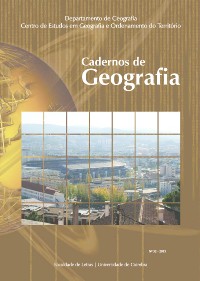Please use this identifier to cite or link to this item:
https://hdl.handle.net/10316.2/30205| Title: | Três décadas de incêndios florestais em Portugal: incidência regional e principais fatores responsáveis | Other Titles: | Trois décennies d’incendies de forêt au Portugal: l’incidence régionale et les principaux facteurs responsables Three decades of forest fires in Portugal: regional incidence and main driving forces |
Authors: | Nunes, Adélia Lourenço, Luciano Bento-Gonçalves, António Vieira, António |
Keywords: | Ignitions;Burnt area;Regional variability;Main driving forces;Portugal;Ignitions;Superficie brûlée;Variabilité régionale;Facteurs responsables;Portugal;Ignições;Área ardida;Variabilidade regional;Fatores responsáveis;Portugal | Issue Date: | 2013 | Publisher: | Faculdade de Letras da Universidade de Coimbra, Departamento de Geografia | Abstract: | Os incêndios florestais constituem, em Portugal continental, o mais relevante problema ambiental e, frequen-
temente, têm sido explicados pelas características climáticas e meteorológicas do nosso território, por estas afetarem
tanto o desenvolvimento como a inflamabilidade dos combustíveis. Todavia, o perfil do clima português, mediterrâneo,
não justifica, por si só, nem o elevado número de ignições, nem a vasta área ardida ao longo destas últimas três déca-
das. Com o presente trabalho, pretende-se avaliar a evolução e as tendências da distribuição regional, quer das ocor-
rências quer das áreas ardidas em Portugal continental, desde 1981 até 2010, bem como identificar inter-relações, ao
nível do distrito, entre variáveis biofísicas, trajectórias sócio-demográficas e incidência de incêndios florestais. Les feux de forêt au Portugal continental, sont le problème environnemental le plus important et ont souvent été expliquée par les caractéristiques climatiques et météorologiques de notre territoire, parce qu’ils affectent à la fois la disponibilité et l’inflammabilité des combustibles. Toutefois, le profil du climat portugais, méditerranéen, n’explique pas, à lui seul, ni le nombre élevé d’ignitions ni la vaste superficie brûlée au cours de ces trois dernières décennies. Le présent travail vise à évaluer les progrès et les tendances dans la répartition régionale des occurrences et les superficies brûlées du Portugal continental, de 1981 à 2010, et d’identifier les inter-relations au niveau du district, entre les varia- bles biophysiques, les trajectoires socio-démographiques et l’incidence des incendies de forêt. Forest fires constitute, in Portugal mainland, the most relevant environmental problem and have been frequently explained by the climatic and meteorological characteristics of our territory, affecting both the availability and flamma- bility of fuels. However, the Mediterranean profile of the Portuguese climate does not justify, per se, neither the high number of ignition nor the large burnt area over the last three decades. The purpose of this paper was to analyze the evolution and tendencies in regional distribution of both forest fire ignitions and burnt areas in mainland Portugal, since 1981 until 2010, and to identify the relationship between biophysical variables and socio-demographic trajectories and the incidence of forest fires at the district level. |
URI: | https://hdl.handle.net/10316.2/30205 | ISSN: | 0871-1623 | DOI: | 10.14195/0871-1623_32_10 |
| Appears in Collections: | Cadernos de Geografia |
Files in This Item:
| File | Description | Size | Format | |
|---|---|---|---|---|
| cg32_artigo12.pdf | 788.67 kB | Adobe PDF |  |
Items in DSpace are protected by copyright, with all rights reserved, unless otherwise indicated.
